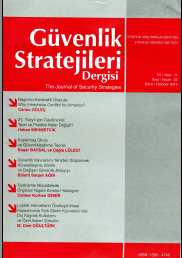21. Yüzyıl için Caydırıcılık: Teori ve Pratikte Neler Değişti?
Deterrence for 21st Century: Changes in Theory and Practice?
Author(s): Hakan MehmetcikSubject(s): Politics / Political Sciences, Security and defense, Military policy
Published by: Atatürk Stratejik Araştırmalar Enstitüsü
Keywords: Deterrence; Classic Deterrence Theory; Extended Deterrence; Coercive Diplomacy
Summary/Abstract: Deterrence/Nuclear deterrence, which was theoretically the most developed and practically the best-applied strategy in the Cold War era, became one of the most important tools for the states to conduct foreign policy at the strategic level. Deterrence, as a product of the Cold War, which was itself a product of bipolar world order and mutual assured destruction between two heavily nuclear-armed super powers, had been developed gradually and studied heavily. Yet, with the end of the Cold War, it somehow lost its attraction for a while. However, with the 9/11 and recent developments in the Eastern Europe and wider Asia, it reiterated its position as the interests on deterrence studies extend. The aim of this article is to analyze the requirement of 21st century deterrence by presenting a brief of the nature and development of deterrence theory and practice. To this end, this article presents a comparative analysis of today’s deterrence theory and practice by analyzing deterrence as a concept, classic deterrence theory, and critics to the classic deterrence theory with a comparative methodology. As an integrated analysis, which is inadequate in Turkish literature on deterrence, the article has a unique contribution to existing literature.
Journal: Güvenlik Stratejileri Dergisi
- Issue Year: 11/2015
- Issue No: 22
- Page Range: 31-59
- Page Count: 30
- Language: Turkish

